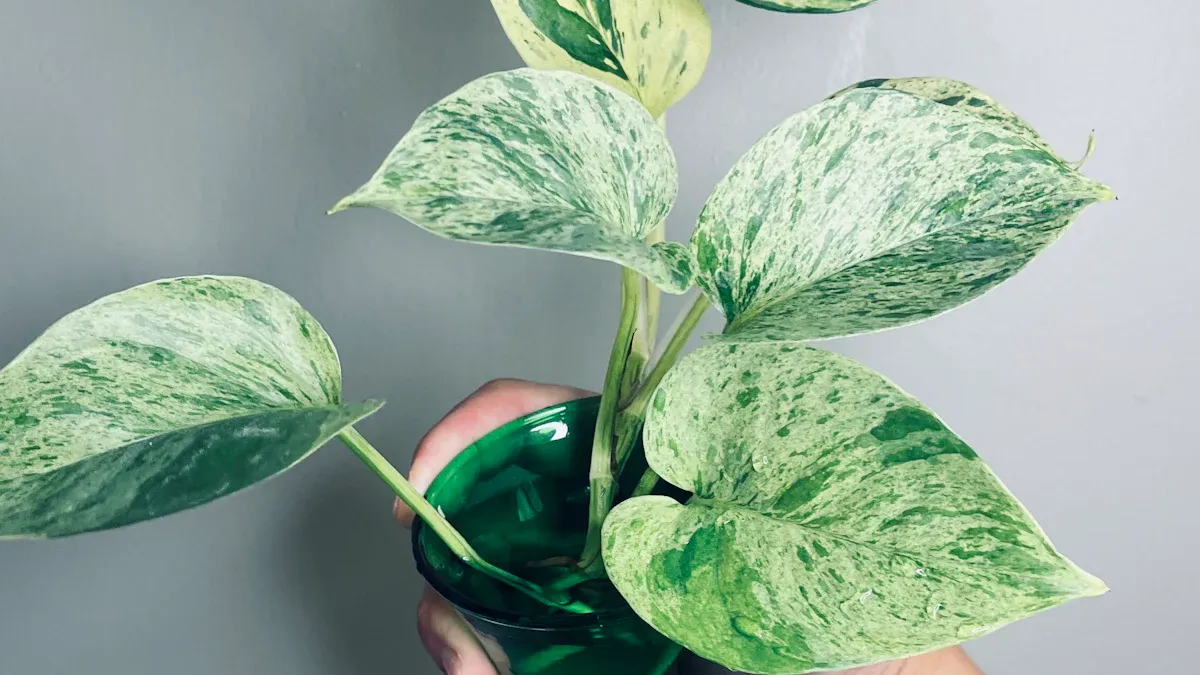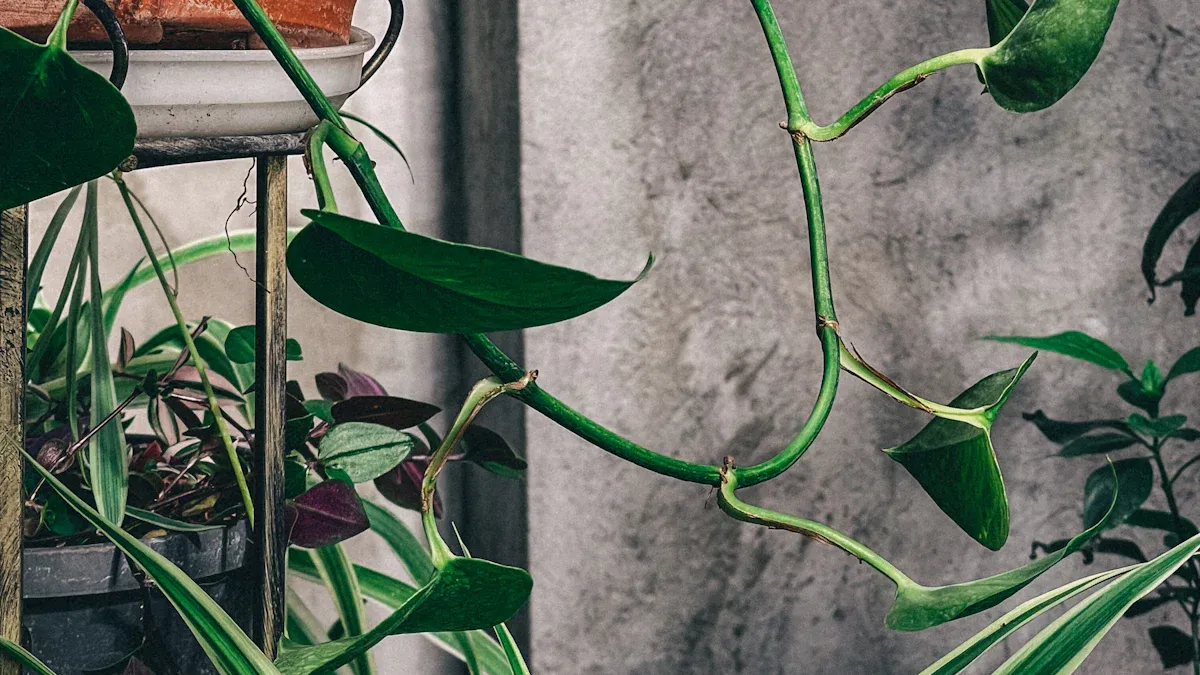
If you’re looking for a stunning addition to your indoor plant collection, Brazilian Pothos plants are a fantastic choice. These houseplants have gained immense popularity due to their vibrant colors and ease of care. With various types available, it’s essential to understand their unique features. This knowledge helps you choose the perfect pothos variety that fits your personal style and your home’s environment.
Key Takeaways
Brazilian Pothos plants are popular for their vibrant colors and easy care, making them great for indoor spaces.
Different varieties like Golden, Marble Queen, and Neon Pothos each have unique leaf colors and growth habits, allowing you to choose based on your style.
Proper light and watering are crucial for healthy growth; aim for bright, indirect light and check soil moisture before watering.
Common issues include overwatering and yellowing leaves; understanding these can help you keep your pothos thriving.
Take your time to select the right pothos variety that fits your home environment and care preferences for the best results.
Types of Pothos

Golden Pothos
Golden Pothos is one of the most popular pothos plant varieties. You’ll recognize it by its vibrant yellow and green leaves that create a stunning contrast. This variety thrives in various light conditions, making it an excellent choice for beginners. Under optimal indoor conditions, Golden Pothos typically exhibits a moderate to fast growth rate, especially during the warmer months. However, you might notice that growth slows down significantly in winter or low-light environments. If you want a plant that can adapt well to your home, Golden Pothos is a fantastic option.
Marble Queen Pothos
Next up is the Marble Queen Pothos, which stands out with its striking leaf patterns. The heart-shaped leaves are heavily splashed and streaked with creamy white, creating a highly variegated appearance. Each leaf is unique, showcasing bright creamy variegation over deep green foliage. This variety has a slower growth rate compared to Golden Pothos, so you’ll need to be patient as it develops. When caring for Marble Queen, it’s essential to provide bright indirect light to maintain its vibrant colors.
Care Requirement | Marble Queen Pothos | Golden Pothos |
|---|---|---|
Light | Bright indirect light | Tolerates lower light |
Fertilization Frequency | Every 6-8 weeks | Once per month in spring/summer |
Growth Rate | Slower | Faster |
Neon Pothos
If you’re looking for a pop of color, consider the Neon Pothos. This variety features bright chartreuse or golden yellow leaves that truly stand out. Unlike other types of pothos, Neon Pothos has no variegation, which makes its vibrant color even more striking. Younger leaves are brighter than older ones, and the color deepens with age. To keep those leaves looking their best, place your Neon Pothos in bright indirect light. It can tolerate lower light, but you’ll notice the leaves may darken and lose their vibrancy.
To maintain the chartreuse color, avoid low light conditions, as this can cause the leaves to revert to solid green. Regularly rotating the plant helps ensure even growth, especially if it receives light from one side. More sunlight leads to brighter neon colors and fuller growth, so consider hanging baskets or shelves for optimal placement.
Manjula Pothos
Manjula Pothos is a unique variety that you might find captivating. It features wide, heart-shaped leaves with a stunning variegation of silver, white, cream, and light green. The leaves often have large patches of green and are heavily flecked or splashed with other colors. This variety is known for its wavy edges, which set it apart from the flatter leaves of other pothos types. While it was once considered rare, the Manjula Pothos has become more common and affordable over time, making it a desirable choice for collectors.
Jessenia Pothos
Lastly, let’s talk about Jessenia Pothos. This variety is characterized by its green heart-shaped leaves marked with a distinct limey-green variegation. Compared to other popular pothos varieties, Jessenia tends to grow more slowly. In a side-by-side comparison, you’ll see that its variegation differs from the more typical yellow and green seen in Golden Pothos. The leaves of Jessenia have a watercolor-like appearance, giving it a unique charm.
Variety | Leaf Color | Variegation Pattern | Growth Habit |
|---|---|---|---|
Jessenia Pothos | Green heart-shaped leaves | Limey-green variegation | Slower growth |
Marble Queen | Lighter green/white | Creamy white variegation | Moderate growth |
Neon Pothos | Bright chartreuse/yellow | No variegation | Moderate growth |
Golden Pothos | Yellow and green | Yellow and green variegation | Faster growth |
Each of these types of pothos brings something special to your indoor garden. Whether you prefer the classic look of Golden Pothos or the unique patterns of Marble Queen, there’s a variety that will fit your style and care preferences.
Characteristics of Brazilian Pothos Plants

Leaf Color and Patterns
When you look at Brazilian Pothos plants, the first thing that catches your eye is their stunning foliage. Each variety showcases unique leaf colors and patterns that can enhance any indoor space. For instance, the Golden Pothos features dark green leaves with golden scatter variegations, while the Marble Queen displays a beautiful mix of cream and green. Here’s a quick comparison of some popular varieties:
Pothos Variety | Leaf Characteristics |
|---|---|
Golden Pothos | Dark Green leaves with golden scatter variegations. |
Neon Pothos | Lime green or Chartreuse leaves. |
Marble Queen | Cream and green variegations – Typically heavier to green than whites. |
Jessenia Pothos | Green leaves with limey-green variegation. |
You’ll notice that Pothos leaves have a thicker, waxy feel and a slightly raised texture. The midrib of the leaves is indented, resembling a gardening spade. This texture not only adds to their appeal but also helps the plant retain moisture. In contrast, Philodendron leaves are thinner and smoother, making it easy to distinguish between the two.
Growth Habit
Understanding the growth habit of Brazilian Pothos plants can help you decide where to place them in your home. These plants are known for their long, cascading vines, making them perfect for hanging baskets or as climbing plants. They can grow quite rapidly under the right conditions, often outpacing other common houseplants.
Here’s a quick overview of their growth habits:
Aspect | Details |
|---|---|
Light Preference | Prefers bright, indirect light but can tolerate lower light levels. Excessive direct sunlight can burn leaves. |
Watering Needs | Requires watering when the top inch of soil is dry; prefers slightly moist soil without being soggy. |
Humidity Requirements | Enjoys a bit of humidity; misting or using a humidifier can help simulate its natural environment. |
Growth Habit | Can grow long, cascading vines; suitable for hanging baskets or as a climbing plant. Pruning promotes bushier growth. |
To keep your Brazilian Pothos thriving, remember to check the top inch of soil for dryness before watering. This simple step helps prevent root rot and promotes healthy growth.
Light and Water Needs
Light and water are crucial for the health of your Brazilian Pothos plants. They thrive in bright, indirect light but can adapt to lower light conditions. However, if you want to maintain their vibrant foliage, providing adequate light is essential.
When it comes to watering, here are some tips to keep in mind:
Check the top inch of soil for dryness before watering.
Water when the top layer of soil is dry to prevent root rot.
Consider environmental factors like pot size, humidity, and season for watering frequency.
By following these guidelines, you can ensure that your Brazilian Pothos plants remain healthy and vibrant, adding beauty to your indoor space.
Care Tips for Pothos
Taking care of your Brazilian Pothos plants can be a rewarding experience, but you might encounter some common issues along the way. Here are a few care tips to help you keep your pothos thriving.
Common Care Issues
Many plant owners face similar challenges with their pothos. Here are some frequent care issues you might encounter:
Overwatering: This is one of the most common problems. Too much water can lead to root rot, which can be fatal for your plant.
Yellowing Leaves: If you notice your leaves turning yellow, it could be a sign of overwatering or underwatering.
Brown Spots: These can indicate that your plant is getting too much direct sunlight or has a nutrient deficiency.
Root Rot: This occurs when the roots sit in waterlogged soil, leading to mushy stems and yellowing leaves.
These issues often arise from improper watering practices, incorrect light levels, and nutrient imbalances.
Best Practices for Healthy Growth
To ensure your pothos thrives, follow these best practices:
Watering: Check the top inch of soil for dryness before watering. This helps prevent overwatering and root rot.
Light: Place your pothos in bright, indirect light. While they can tolerate lower light, this may lead to slower growth and less vibrant leaves.
Soil: Use a well-draining potting mix. A combination of coconut coir, perlite, and orchid bark works wonders for drainage and aeration.
Fertilization: Fertilize during spring and summer, about once a month. Use a balanced fertilizer with an NPK ratio of 3-1-2 or 2-2-2. This helps promote robust foliage.
Here’s a quick look at the primary causes of yellowing leaves:
Cause | Description |
|---|---|
Underwatering | Yellow leaves may indicate that the plant is not receiving enough water, leading to droopy and limp vines. |
Overwatering | Excess water can suffocate roots, causing yellowing leaves and wilting. |
Improper Watering | Inconsistent watering can stress the plant, leading to yellow leaves. Proper watering techniques can help maintain plant health. |
Root Bound | If the plant has outgrown its pot, it may become root bound, resulting in yellowing leaves and stunted growth. |
Root Rot | Caused by pathogens in waterlogged soil, root rot leads to yellow leaves and mushy stems. Inspecting the roots can help identify this issue. |
By following these pothos care tips, you can enjoy a healthy and vibrant indoor plant that brightens your space.
Choosing the right Brazilian Pothos variety can significantly impact your indoor space’s aesthetic. Each type offers unique colors, leaf shapes, and textures. For example, the Marble Queen Pothos adds a dramatic flair with its striking white veins, while the Golden Pothos brings vibrant energy with its bright yellow and green leaves.
When selecting a pothos plant, consider factors like light, temperature, and humidity. Most varieties thrive in medium to bright indirect light. They prefer a temperature range of 65-85℉ and humidity levels between 40-60%. By understanding these needs, you can create a thriving environment for your plants.
Ultimately, take your time to find the perfect Brazilian Pothos that fits your style and care capabilities. Happy planting! 🌱
FAQ
What is the best light for pothos plants?
Pothos plants thrive in bright, indirect light. They can tolerate low light but may lose their vibrant colors. For optimal growth, place them near a window with filtered sunlight.
How often should I water my pothos?
Water your pothos when the top inch of soil feels dry. This usually means watering every 1-2 weeks, depending on your home’s humidity and temperature.
Can pothos survive in low light?
Yes, pothos can survive in low light conditions. However, their growth may slow down, and the leaves might lose some vibrancy. Bright, indirect light is best for healthy growth.
How do I propagate pothos plants?
You can propagate pothos by cutting a stem just below a node and placing it in water or soil. Roots will develop in a few weeks, allowing you to grow a new plant.
Why are my pothos leaves turning yellow?
Yellowing leaves can indicate overwatering or underwatering. Check the soil moisture and adjust your watering routine accordingly. Ensure your pothos gets enough light to maintain healthy foliage.

